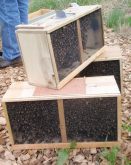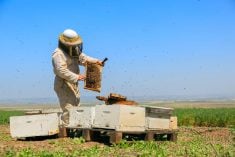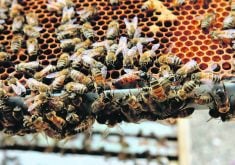The worst may be over for Canadian honey producers, following three straight years of devastating overwinter bee colony losses.
A new survey shows beekeepers lost 21 per cent of their colonies last winter, much less than in previous years.
But officials warn it’s premature to say the industry has turned a corner in its fight to stem large honeybee losses across Canada.
“It is too early to determine whether this decline in mortality constitutes a sustained improvement in colony health,” says the survey done by the Canadian Association of Professional Apiculturists.
Read Also

Beekeepers want financial protection against tropi mite
What happens to beekeepers if the deadly tropi mite reaches Canada? Discover why farmers want robust compensation to protect pollination.
The survey showed Canadian beekeepers overwintered 611,972 colonies during the winter of 2009-10. The number of dead or unproductive colonies in spring totalled 128,463.
The 21 per cent national winter loss rate was still 1.4 times higher than the long-term rate of 15 per cent.
LOSS RATES
But it is substantially better than loss rates of 33.9, 35 and 29 per cent recorded for the winters of 2008-09, 2007-08 and 2006-07 respectively, CAPA said in its survey released Oct. 15.
Manitoba lost 25.6 per cent of its colonies last winter, also an improvement over previous years. Producers lost 32 per cent of their colonies during the winter of 2008-09.
Across Canada, wintering losses ranged from a high of 41.9 per cent in Nova Scotia to a low of 16.7 per cent in Prince Edward Island. Although overall losses improved in 2009- 10, a notable exception was Vancouver Island, where nearly 70 per cent of all colonies were lost, CAPA reported.
Meanwhile, in the United States, losses continued high. U. S. government and industry surveys recorded a 33.8 per cent loss of managed honeybee colonies.
Beekeepers throughout Canada and the United States have been plagued by a high die-off of colonies for four straight years, but no one is quite sure why.
VANISHED
Much attention has gone to a syndrome called Colony Collapse Disorder, a phenomenon reported in the U. S. Bees sometimes vanish mysteriously from their hives for no apparent reason and are never found.
But scientists now feel CCD is overblown and a combination of factors is likely responsible for recurring losses.
Classic CCD-like symptoms have not been identified in Canada.
David Ostermann, a pollination apiarist with Manitoba Agriculture, Food and Rural Initiatives, credited Apivar, a new insecticide to control varroa mites in hives, for the drop in lost colonies.
Apivar, which contains the active ingredient Amitraz, recently became available to beekeepers under emergency use registration.
The parasitic varroa is considered a major reason for the decline in colony numbers. Besides weakening bees, the mite can also transmit viruses and other pathogens. Chemicals used to control the varroa can linger in hives and further affect bees.
Ostermann said an early spring this year was another reason for fewer colony losses. Beekeepers were able to get in early, split up surviving hives and partially compensate for winter losses.
LOWER LEVELS
Early reports from producers indicate varroa levels are lower this fall than they were last year, said Ostermann. Warm weather this fall is also good for colonies. Beekeepers are able to feed hives, prepare them for winter and get on top of bee health issues.
But Ostermann warned a long, cold winter could bring a return to high colony losses next spring.
The presence of the varroa, endemic in hives throughout North America, will continue to threaten the industry, he added.
“If the varroa ever goes away, then I’ll be comfortable saying things are better. But the varroa will never go away, so it’s an ongoing struggle.”
Manitoba stands to harvest an average honey crop this year, despite heavy rains and widespread flooding. Preliminary reports indicate honey production will be around 165 pounds per colony, close to the long-term average yield, Ostermann said.
Western Manitoba and the Interlake region were hardest hit by excess moisture. Closer to Winnipeg, though, warmer temperatures generated slightly above-average honey production, said Ostermann. [email protected]
———
“Thevarroawill nevergoaway.”
– DAVID OSTERMANN, MAFRI














